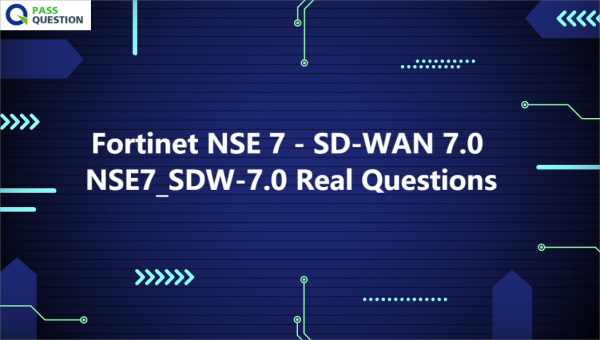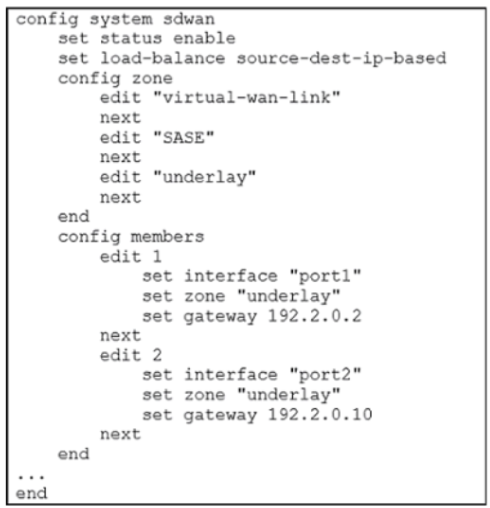Fortinet NSE 7 - SD-WAN 7.0 NSE7_SDW-7.0 Real Questions
To help candidates prepare for the Fortinet NSE7_SDW-7.0 exam, PassQuestion has developed a comprehensive set of Fortinet NSE 7 - SD-WAN 7.0 NSE7_SDW-7.0 Real Questions for effective exam preparation. The Fortinet NSE 7 - SD-WAN 7.0 NSE7_SDW-7.0 Real Questions cover all the key topics and domains outlined in the NSE7_SDW-7.0 exam blueprint, ensuring candidates have a thorough understanding of the subject matter. PassQuestion Fortinet NSE 7 - SD-WAN 7.0 NSE7_SDW-7.0 Real Questions are regularly updated to align with the latest exam objectives and industry trends, ensuring that candidates receive the most relevant and accurate information.It will help you gain confidence and increase their chances of passing the NSE7_SDW-7.0 exam successfully.

Fortinet NSE 7—SD-WAN 7.0
The Fortinet NSE 7—SD-WAN 7.0 exam is part of the NSE 7 Network Security Architect program, and recognizes the successful candidate’s knowledge and expertise with the Fortinet SD-WAN solution. The exam tests applied knowledge of the integration, administration, troubleshooting, and central management of a secure SD-WAN solution composed of FortiOS 7.0.3, FortiManager 7.0.2, and FortiAnalyzer 7.0.2.
The Fortinet NSE 7—SD-WAN 7.0 exam is intended for network and security professionals who are responsible for the design, administration, and support of a secure SD-WAN infrastructure composed of many FortiGate devices.
Exam Details
Exam name Fortinet NSE 7—SD-WAN 7.0
Exam series NSE7_SDW-7.0
Time allowed 60 minutes
Exam questions 35 multiple-choice questions
Scoring Pass or fail, a score report is available from your Pearson VUE account
Language English
Product version FortiOS 7.0.3, FortiManager 7.0.2, FortiAnalyzer 7.0.2
Topics of the NSE7_SDW-7.0 Exam:
The NSE7_SDW-7.0 exam is an industry-recognized certification offered by Fortinet. It is designed for network security professionals, solution architects, and system engineers who are responsible for deploying and managing Fortinet Secure SD-WAN solutions in complex enterprise environments.
The exam focuses on testing the candidates' knowledge and skills in the following key areas:
SD-WAN configuration
Configure a basic SD-WAN DIA setup
Configure SD-WAN Members and Performance SLAs
Configure SD-WAN rules
Configure SD-WAN routing
Configure SD-WAN traffic shaping
Centralized management
Configure and monitor an SD-WAN deployment from FortiManager
Advanced IPsec VPN
Deploy a hub-and-spoke IPsec topology for SD-WAN and ADVPN
SD-WAN troubleshooting
Troubleshoot SD-WAN
View Online Fortinet NSE 7 - SD-WAN 7.0 NSE7_SDW-7.0 Free Questions
1. What are two reasons why FortiGate would be unable to complete the zero-touch provisioning process? (Choose two.)
A.The FortiGate cloud key has not been added to the FortiGate cloud portal.
B.FortiDeploy has connected with FortiGate and provided the initial configuration to contact FortiManager
C.The zero-touch provisioning process has completed internally, behind FortiGate.
D.FortiGate has obtained a configuration from the platform template in FortiGate cloud.
E.A factory reset performed on FortiGate.
Answer: A, C
2. Which components make up the secure SD-WAN solution?
A.Application, antivirus, and URL, and SSL inspection
B.Datacenter, branch offices, and public cloud
C.FortiGate, FortiManager, FortiAnalyzer, and FortiDeploy
D.Telephone, ISDN, and telecom network.
Answer: C
3. In a hub-and-spoke topology, what are two advantages of enabling ADVPN on the IPsec overlays? (Choose two.)
A.It provides the benefits of a full-mesh topology in a hub-and-spoke network.
B.It provides direct connectivity between spokes by creating shortcuts.
C.It enables spokes to bypass the hub during shortcut negotiation.
D.It enables spokes to establish shortcuts to third-party gateways.
Answer: A, B
4. Which are three key routing principles in SD-WAN? (Choose three.)
A.FortiGate performs route lookups for new sessions only.
B.Regular policy routes have precedence over SD-WAN rules.
C.SD-WAN rules have precedence over ISDB routes.
D.By default, SD-WAN members are skipped if they do not have a valid route to the destination.
E.By default, SD-WAN rules are skipped if the best route to the destination is not an SD-WAN member.
Answer: B, D, E
5. Refer to the exhibit.

Which algorithm does SD-WAN use to distribute traffic that does not match any of the SD-WAN rules?
A.All traffic from a source IP to a destination IP is sent to the same interface.
B.All traffic from a source IP is sent to the same interface.
C.All traffic from a source IP is sent to the most used interface.
D.All traffic from a source IP to a destination IP is sent to the least used interface.
Answer: A
- TOP 50 Exam Questions
-
Exam
All copyrights reserved 2025 PassQuestion NETWORK CO.,LIMITED. All Rights Reserved.

